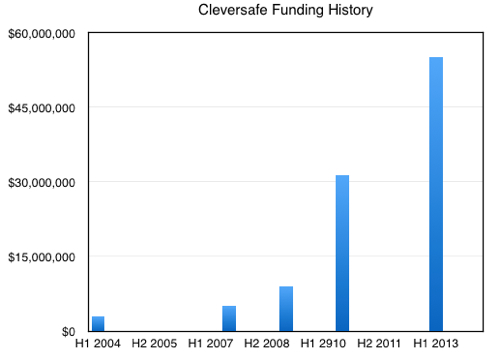This article is more than 1 year old
How much data must you have before you need Cleversafe? If you have to ask ...
We could tell you who has enough, but then we'd have to kill you
The Data IS the Network. No wait, other way round
That was the insight; treat data like a packet-switched network which stores the data after ingest instead of transmitting it across a network. The data persists and has state. Gladwin realised he could provide seed funding himself, talked to VCs, and set up a dev team in Chicago - based at Illinois Institute of Technology, recruiting masters and grad students. The team had three components to it:
- 20 per cent were storage experts
- 30 per cent came with telco networking experience, not storage networking
- 50 per cent "were brilliant young minds," grad computer science students. "These guys didn't know what they didn't know," and weren't held back by notions of what couldn't be done.
These people have developed Cleversafe's object storage technology, the dsNet system and its ClevOS software.
Gladwin wanted many nines of data reliability, telco reliability levels. At that time, 2004, this was a relatively rare thing for storage. Development took a long time with much prototype testing by potential customers; one a not-for-profit broadcast media museum. There was also much patent activity; with 150 awarded patents today and 450, perhaps more, in preparation. The first product was formally shipped in 2010.
The idea was to sell to customers with a petabyte or more of storage, and these were large and expensive systems needing direct sales or sophisticated partners. Why that big? Because Cleversafe's object storage technology systems get better as they get bigger while the mainstream vendors' competing products get worse as they get bigger.
Gladwin says that his target customer market overlaps the high-end of object storage competitor Scality's market but goes on to much higher scale. Cleversafe says its approach "delivers the powerful combination of analytics and storage in a geographically distributed single system, allowing organisations to efficiently scale their big data environments to hundreds of petabytes, and even exabytes, today."
As development progressed VCs came in with several funding rounds; here's a funding history chart;

Look at that steady progression, with rising amounts invested in subsequent rounds; it looks like a classic 4-rounds to IPO pattern. With one round, the $9.01 million B-round, an interesting technology advisory board member arrived; Alan Wade, a former Central Intelligence Agency CIO. He retired from the agency in 2006 after spending 35 years there. A C-round took place in 2010, involving $31.4 million, and a new investor joined the participating original VCs, IN-Q-TEL, which says of itself: "We identify, adapt, and deliver innovative technology solutions to support the missions of the Central Intelligence Agency and broader U.S. Intelligence Community."
